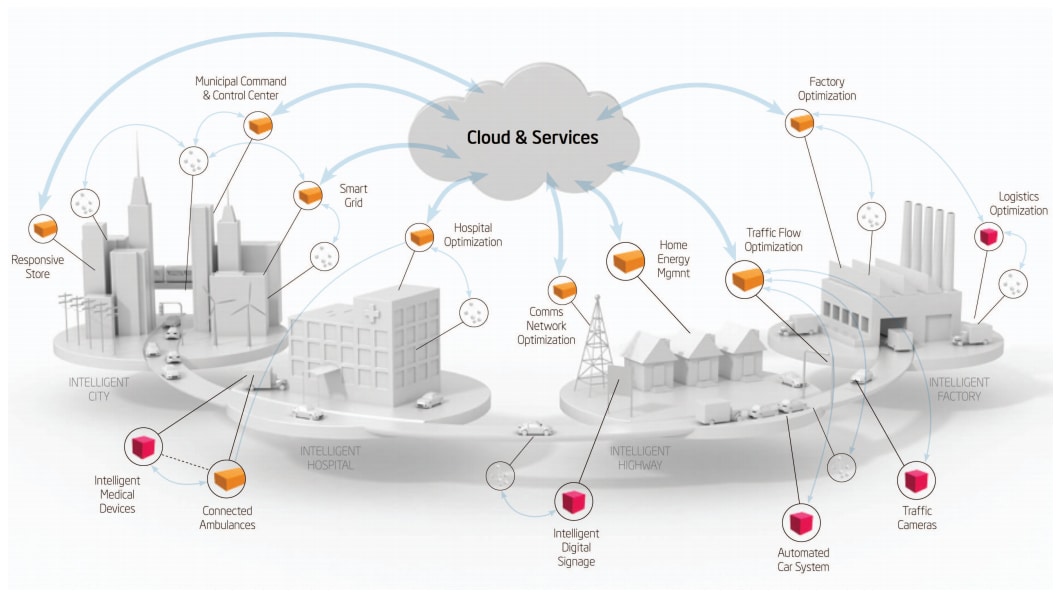-
Phone Number
-
Email Address
Wishing it or not, the reality is that we are moving towards a way of understanding life totally "connected" to the network, and this will affect the way of understanding cities and the way of inhabit them, the architecture, the interior design, the advertising or design among many other aspects.
And this is where the example comes in. of the Internet of Things ( Internet of Things – IoT , for its acronym in English)…. Do you think that an orchid will be able to count its history? Do you think it is possible to teach the building to speak or change color according to the weather outside? Do you think, a car can call an ambulance faster than a telephone? Can you imagine an ambulance gathering critical information of the patient before arriving at the hospital?
Content menu:
Mainly this concept comes from a work of advanced science and technology that was published in 1999, When things start to think , from the researcherodor Neil Gershenfeld of MIT. He wrote… “In addition to try to make computers everywhere, we should try to keep them out of the way.”
The term IoT technology is capable of to talk to each other, that they have an identity, that there is a control of objects, that detect their environment and adopt decisions according to specific needs to help us in our daily life.
This aspect is revolutionizing the different sectors of the internet industry, including the way of living and understand buildings, home or transportation. In the following graphs we can identify the evolution that is having and the speed of adoption by sectors… How smart are are things today?
An Internet revolution in that everything is connected to the network …

For a greater global perspective and understanding, we add as example of internet of things the next video. Openarch is a real prototype of a smart home, a Thinkbig project Factory.
The first house designed from the beginning to incorporate a digital layer that connects the house and its elements to the Internet network . It represents the sum of many small applications of new technologies in the home, for this, devices such as Kinect, webcams, projectors with multiple sensors to measure from the CO2 to electricity consumption.
The works and constructions begin to feel the pulse technology that provide new control capabilities, real-time data and resource efficiency on the Projects. From MIT they provide us with one of the most interesting to be able to recognize the most relevant aspects of utility:

In the following video we can test an example of how it will be any given day where technology is completely integrated into our daily lives with the IoT:
Obviously the term IoT cuts through architecture or interior design of houses represented in one word that we all already know, the Smart Cities .
Those futuristic and intelligent cities that “theoretically” provide us with a kinder life through different mega-connected systems, an improved habitat, more security, environmental sustainability, where efficiency energy of things will be enhanced to its fullest and, which are currently so fashionable.
We remember the article
Cilab’s Smart City is an advertising video about how the Internet technologies of things can make our cities smarter and minimize the environmental impact of our activities daily.
We can already identify that the new capabilities of Internet of objects moves a lot money. In the article of the Economist since HERE …. « It will mean worldwide savings of 14.5 trillion euros. European billions. Eleven of them correspond to the environment private and the rest public. Because it would translate into management more efficient use of assets (including energy management in intelligent buildings) and in improvements of the productivity.”
Although we can verify that it can undoubtedly contribute benefits to society or individually, provided there is a but, some advantages and disadvantages of Internet of things that we want to show. Without enter into the discussion of… Who behind? Looking at the big companies in the electronics and its many "hidden" interests.
Examples of IOTS or the famed Internet of Things we can find many and more, if we delve into the different "cachibaches" and systems that every day flood the technological market; from mobile APPS to measure anything or let us know, objects intelligent who speak and think, to the last vacuum cleaner that knows when our house is dirty…. we left various Internet of Things examples :
The first is some smart "stickers" that are added to objects to provide data about them, we only have to program (they are already easily defined) who want let us know.
An example, it is added to a pot and it will tell us when it is the last time we watered it or, depending on the temperature where it is Find out if you need more or less water…

An example of smart technology is a sensor for the garden The device records data on temperature, sunlight, humidity or the level of fertilizer in the soil.
It is evident that the technology is being implemented with great hardness in the daily life of our houses. An example is the next video…
A time is coming an evolution (revolution, according to many) that is based on the connection of all sorts of devices, including many that often we do not believe that they can be connected... In the The following TED talk explains the future of this trend.
Links of interest to the portal:
If you liked the article, rate it and share!